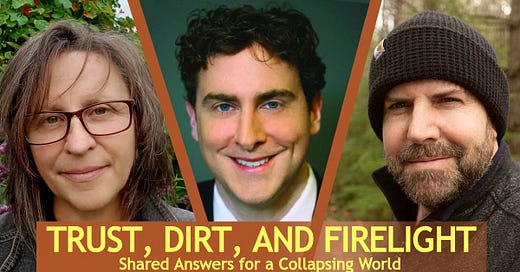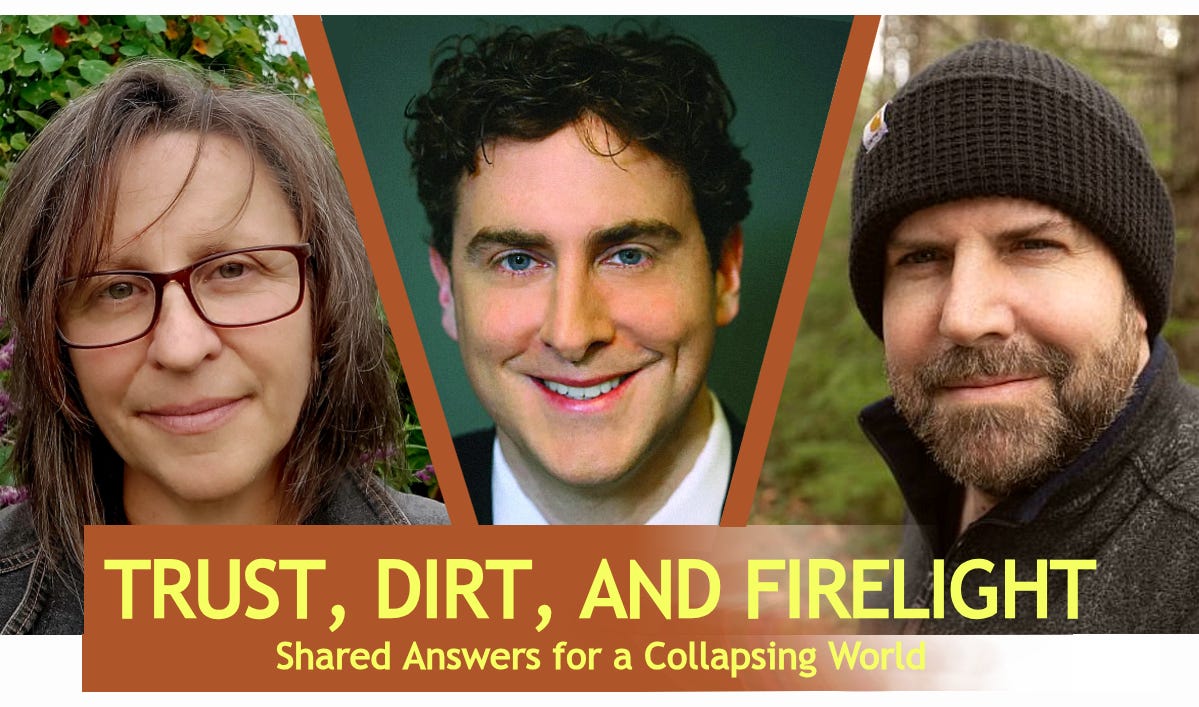We didn’t plant the tree of survival twenty years ago. Now, storms are here—and there's no more time to waste. In this raw, practical, and unflinching guide, three collapse-aware thinkers answer six urgent questions about building resilience, growing food, forming survival networks, and finding meaning in a world coming apart. It’s not about bunkers or billionaires—it’s about skills, soil, and solidarity. Read it now. Share it like firelight.
We are three Substack authors—Justin McAffee (Collapse Curriculum), Matt Orsagh (Degrowth is the Answer), and Margi Prideaux (Radically Local)—who are often asked by our readers how to “survive what’s coming”. That might be social collapse, or climate collapse, or resource scarcity. As individuals, we have some answers, born of our experience and expertise, but together we thought we might provide something richer and deeper.
Society should have planted the tree of survival twenty years ago. But we didn’t. So now the only time left is today—today, while the storms gather and the soil slips—with heavy grief, stubborn hope and firelight. Flickering, shared, enough to see each other by.
Here are our brief answers to six common questions about surviving in a collapsing world.
Can we build resilience fast enough to cope with the cascading crises ahead?
From Justin:
No one knows exactly how far the damage will go. There’s no crystal ball—just cascading variables, blind spots, and runaway feedback loops. We can expect widespread human suffering, the biosphere staggering under the weight of collapse, and extinctions accelerating. That’s already in motion. But how far it goes? How much carrying capacity we’ve already burned through, and how much remains? That part’s unclear. We’re moving through the fog, but we know we’re descending.
Here’s what we do know. We can choose to find meaning in building resilience either way, and there’s no question it will help people as collapse happens. Building resilience isn’t just about stockpiling supplies or learning wilderness skills—it’s about adapting mentally, socially, and structurally to a world of cascading crises. And it starts with understanding that we’re already late. The collapse of climate, economies, food systems, and social cohesion is not a future threat—it’s happening now.
Resilience begins with mental adaptation. We must shed illusions of return-to-normal and embrace uncertainty. We can embrace what some call “post-hope pragmatism”—acknowledging collapse not to give up, but to focus on what we can do. This mindset shift is urgent. People freeze in denial while precious time slips away. Emotional resilience—grief literacy, courage, mutual support—is foundational.
Next, we need community-scale resilience. No individual, no matter how skilled, thrives in isolation. Rapidly forming local networks of mutual aid, food co-ops, defense groups, and shared childcare is more impactful than any lone survivalist plan. Cadres—small, resilient, trust-based units—are the fastest and most flexible way to scale up response and recovery efforts when institutions fail.
We also need resilient systems—not fragile supply chains. Start small: localized food, decentralized energy, skill-sharing hubs, peer-to-peer communication. The faster we detach from centralized dependencies, the more shock-absorbent our lives become. Real change doesn’t come from asking systems to change—it comes from creating alternatives and defending them.
Can we build resilience fast enough? The answer depends on whether we stop wasting time trying to save unsalvageable systems and start investing in what will last: land, trust, skills, and solidarity. We don’t need perfection—we need momentum. The storms are coming. The question is whether we’ll face them alone and exposed, or together, grounded and ready.
How do I prepare for a world where resources are scarce and systems are failing?
From Matt:
We are faced with a future in which many of the resources we take for granted today will be scarcer and many of the systems we depend on will be degraded or fail. What can we do to prepare for such a world?
The first thing to do is to accept that such a world is indeed on its way. We can put our heads in the sand and deny that fact or hold out hope that some technological marvel will save us. Neither of those are sound strategies. Denial of reality is never a good option, and waiting for a technological miracle is a fantasy. Any technology that will help us – I’m looking at you AI – will use so much energy that the tradeoffs for any convenience it provides will be offset by the environmental damage it does.
Then there are three things to do to adjust to a post-growth world.
1. Simplify – Those that need less will be less impacted by the changes coming. We will be forced to admit that many of our wants are not needs in the coming years, so it would behoove us all to get ahead of that and simplify our lives and focus on living lives of “enough”. In a crumbling world, luxuries will fall away. Don’t need them, and you won’t miss them.
2. Practice Self-sufficiency – Few, if any of us can be completely self-sufficient, but we should aim to be as much as possible. This could involve growing, or expanding our gardens, living in a place where we can get around on foot or by bike, horse, or other means that don’t depend on fuel that will become undependable.
3. Build and Foster Community – For the many things we can’t provide for ourselves, we will need community. Communities come together more in hard times, and the harder times are coming. Building stronger communities to help with the things we all need that we can’t provide for ourselves will make the future more bearable. So, we should start building those communities today.
How do I build and defend a truly local, self-sustaining food system in a collapsing world?
From Margi:
Growing food for my community has become the core of my life. It’s not a lifestyle choice. It’s not a side project. It’s a daily reckoning with time, failure, and the fragile work of connection. I think about it from dawn to dusk. I dream about it at night. It’s become my whole world. Because I’ve come to understand that food sovereignty—real, grounded, local control over food—starts with hands in soil and builds out from there.
Growing food takes time. Don’t expect to plant carrots when the shelves go empty and eat them the next week. Carrots are in the ground for 4.5 months, minimum. Onions and potatoes take six. Sure, radishes are quick—about four weeks—but they are hardly a balanced diet. So, understand growing takes time and, if you haven't already started, you’ll be hungry for a while. And even then, growing is just the beginning. You’ll need to protect those crops from drought, wildlife, disease, wind, and frost. You’ll need to learn the hard craft of storage—how to keep rodents and rot from stealing your winter calories. You’ll need to feed the soil so it can feed you again—without store-bought fixes that won’t be there when the system buckles. That means manure, compost, cover crops, crop rotation. You’ll need seed—and no, there won’t be a mail-order catalogue. You’ll have to save it, clean it, and store it yourself. All skills most of us have to reclaim from scratch. And they’re not optional if we want to eat. I don’t list this to be demoralising. I hope it’s empowering—that you come to understand you need to start soon.
But growing and a self-sustaining food system are separate layers. Growing for your own household is one thing, but a self-sustaining food system doesn’t come from individual effort—it comes from collective action. Food sovereignty is deeply political. It’s about reclaiming the right to grow, share, and protect food on your terms, with people you trust. So, your task is actually to grow community alongside your cabbages. To build trust, shoulder to shoulder with other people. Food grown in isolation will always be vulnerable. Food grown in community has defenders, watchers, and stewards—swapping stories, seeds, and watch shifts. You can grow more, and better.
Start now. You don’t need to own land. Find the rooftop growers, the parkway tenders, the balcony planters, the community gardeners tucked behind libraries and schools. If you’re in the suburbs or out in the country, find your neighbours who are already growing. Connect with them. Help them. Learn from them. Plant one crop this season. Then two. Build the skills, slowly. But above all, build relationships.
This is where real resilience starts: not with stockpiles or survivalist fantasies, but with people rooted in place, committed to each other. This is what makes a food system unshakeable—not the harvest, but the hands around it.
What skills and strategies do I need to survive what’s coming?
From Justin:
Five Steps To Prepare For What is Coming
To survive what’s coming, you need to shift your mindset and develop a specific set of practical skills and strategic habits. We’re not just talking about outdoor survival—though that’s important—but about psychological resilience, community building, and tactical preparedness for a world in deep transition.
I. Develop a Collapse-Aware Mindset
Accept the likelihood of systemic failure—economic, ecological, social—not with fear, but with clarity. This doesn’t mean despair; it means shifting from dependence on centralized systems to autonomy. Mental toughness, adaptability, and the ability to stay calm under stress are non-negotiable.
II. Build Essential Survival Skills
You’ll need to secure food, water, shelter, and security without modern conveniences. Learn how to purify water, grow or forage food, treat injuries with basic medical knowledge, and maintain warmth and shelter.
III. Master Local Navigation, Communications, And Situational Awareness.
The ability to read terrain, move quietly, observe without being seen, and coordinate with others securely will be vital in times of instability. Think like a scout, not just a survivor.
IV. Organize Or Join A Cadre
Yes… a small, trusted group committed to mutual aid, shared values, and resilience. As collapse accelerates, isolated individuals will struggle. Cadres function as the nucleus for both defense and future rebuilding, rooted in trust, discipline, and purpose.
V. Be Prepared To Resist And Rebuild
Understand the power dynamics that brought us here. Survival isn’t just about enduring—it's about refusing to cooperate with systems that destroy life. Learn when to fight back, when to hide, and when to plant seeds—literally and metaphorically—for a better world.
The goal is not just survival, but meaning. Navigate the end not as a victim, but as a prepared, principled actor.
What does a real survival network look like, and how do I build one?
From Margi:
A real survival network isn’t built on shared politics, curated friendships, or utopian ideals. It’s built on geography, interdependence, and a gritty willingness to work with whoever’s nearby when the truck breaks down or the flames come over the ridge. It’s not always pretty. You may not even like each other. But if you can fix a fence in a storm, take turns on night watch, or share a water tank without resentment—that’s your glue. That’s community.
Don’t waste time chasing the dream of a perfect ‘intentional community’. They exist, sure, but they are a long shot, and a dangerous gamble this late in the game. The future is already here. The deep question you need to ask yourself is: where will you meet it? Decide, then dig in. Because what matters most isn’t where you are—it’s who shows up when it counts. And what they bring. That’s your survival network.
You’ll need growers and seed savers, carers and cooks, welders and mechanics, medics, midwives, weather-watchers, foragers—people who can split wood, read a room, or hold their nerve when things go sideways. You’ll need knowledge of soil, storage, food safety, first aid, and conflict resolution. You’ll need people who can carry both weight and grief. And you’ll need to become one of them.
Start where your feet are. Learn who grows food, who knows tools, who has a truck, who checks in when the power’s out or the cell towers fall silent. Don’t be passive. You also need to practise showing up when it’s inconvenient, and staying when it’s uncomfortable. Build your skills around sharing labour, hard conversations, and not flinching when someone’s views rankle. You don’t need to like everyone. You do need to need them.
Because this isn’t friendship—it’s survival. And a survival network isn’t tidy. The network that carries you won’t look like a commune brochure. It’ll be held together by labour, trust, and repetition. Not perfect people—but present ones. This is how we endure. Not with a gun and a bunker, but with a battered kettle, a fire to boil it on, and people around it who’ve learned to rely on each other. Firelight as currency—not just for heat, but for trust, memory, and belonging.
Is it too late for degrowth, or can we still turn things around?
From Matt:
The best time to plant a tree is twenty years ago. The second-best time to plant a tree is right now.
Yes, it would have been better to recognize the environmental damage from climate change and ecological overshoot twenty years ago (or more) and implement degrowth policies then. But we didn’t do that.
In the meantime, things have gotten worse, as the ecological and environmental damage has increased as we move further beyond the safe operating space and into the red in most planetary boundaries. The work to turn things around will be harder because we have delayed action. But throwing up our hands and saying that things are too far gone to make them better is just accepting a world that will perpetually be worse than the year before.
We have locked in some damage to our environment because we haven’t acted. We have lost species, we have locked in sea level rise, we have locked in a certain level of global warming, we have locked in more extreme weather, we have locked in a certain level of famine, migration, and death.
But continuing to nothing will just lock in something worse.
Because you didn’t plant that tree twenty years ago, today you don’t have it’s shade, you don’t have the oxygen it produces, you don’t have it too hold the soil together, you don’t have the fruit it would give you.
But you need all those things. And you will need them twenty years from now.
Plant the tree today.
We’ve enjoyed pulling this together. If it’s stirred something in you, let us know. Questions, pushback, curiosity—we’re here for all of it. If you want more of this tag-team thinking, say the word.
Pile the questions into the comments and we’ll keep writing.
Justin (Collapse Curriculum),
Matt (Degrowth is the Answer),
and Margi (Radically Local)









